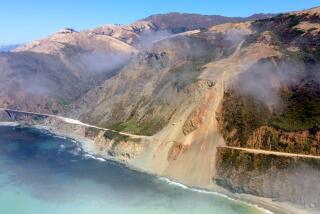‘Blood Alley’ Trees Fall to Save Lives
On a stretch of roadway known as “Blood Alley” between Santa Paula and Fillmore,highway officials saw it as a choice between life and limb.
After years of complaints about the carnage on the stretch of California 126, state Department of Transportation work crews began widening the two-lane roadway to four lanes for safety reasons.
In the process, which started in April, they have cut down several dozen 90-year-old eucalyptus trees that had formed a bower over the dangerous stretch of highway.
“You don’t ever like to have to take a tree out, but we had to, in this case, to widen the road,” said Jim Renshaw, Caltrans resident engineer in charge of the project.
“We haven’t heard of any objections,” he added. “There are a lot of trees that we are leaving in wherever possible. We will be putting guardrails around them.”
Environmentalists who viewed the eucalyptus grove as one of the scenic highlights on the highway conceded that they could have done more to preserve the trees.
“The eucalyptus were very beautiful,” said Russ Baggerly, a spokesman for several environmental groups. “What can I say? It’s something that we missed, I guess.”
One option would have been for environmentalists to campaign for the Ventura County Cultural Affairs Board to declare the eucalyptus stand a county landmark, which would have required Caltrans to give the county 180 days notice of its plans.
Judy Triem, a Santa Paula author and adviser to the Cultural Affairs Board, said an effort was made about two years ago to obtain landmark status for the trees, but that there was never an official follow-up.
“It’s heart-wrenching to see the trees come down,” she said. “But it’s my feeling that in this instance the higher priority was the widening of the road.”
More to Read
Sign up for Essential California
The most important California stories and recommendations in your inbox every morning.
You may occasionally receive promotional content from the Los Angeles Times.










